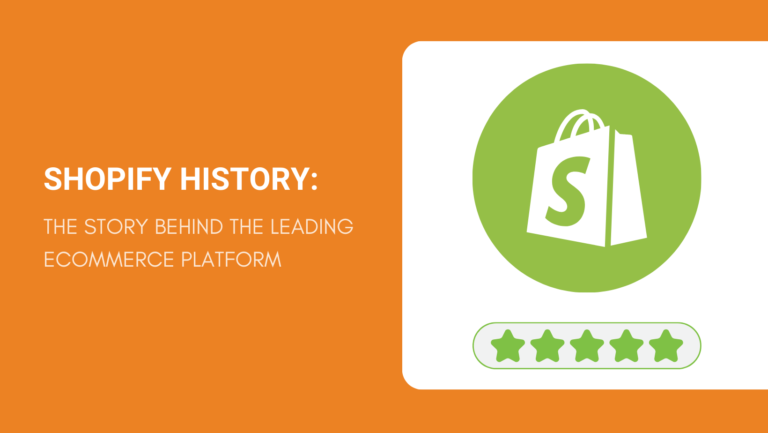When you think of purchasing anything online, chances are you’ve used a site powered by Shopify.
Today, Shopify stands as a leading e-commerce platform that supports the business endeavors of over 1.7 million merchants worldwide.
Its journey began in 2006 when a trio of snowboarding enthusiasts were simply looking to sell their gear on the web and found existing tools too clunky, leading them to create their own solution.
In a digital equivalent of a garage startup, the founders of Shopify transformed their frustration into innovation, crafting an e-commerce platform that would soon revolutionize online selling.
If you’re curious about how Shopify went from a makeshift online snowboard store to a multi-billion dollar entity, you’re not alone.
Dive into the compelling backstory of Shopify and discover how it changed the e-commerce landscape forever.
The Early Days of Shopify

When you look at the e-commerce giant Shopify today, it’s hard to imagine that its journey began as a small online store for snowboarders.
The evolution from a niche market to a leading e-commerce platform started with a few keen minds, and a vision that would later change the face of online retail.
Birth of Snowdevil
In 2004, three friends in Canada—Tobias Lütke, Daniel Weinand, and Scott Lake—decided to start an online store for snowboarding equipment, which they named Snowdevil.
Fueled by their passion for the sport and their frustration with the e-commerce tools available at the time, these founders embarked on a mission to create something better.
Transition to Shopify
The tools needed to sell Snowdevil‘s products effectively online didn’t exist. Your typical online selling platform was clunky and hard to use.
As programmers, Lütke and Weinand, drew on their background to build their own. This custom solution, crafted to meet the needs of their snowboarding business, laid the groundwork for what would become Shopify.
Going Public
Fast forward to 2015, and Shopify made headlines with its Initial Public Offering (IPO) on Wall Street and the Toronto Stock Exchange.
This momentous event signaled Shopify’s transition from a successful startup to a public company, setting the stage for its role as a key player in the global e-commerce market.
The Evolution of the Shopify Platform
Shopify’s growth mirrors the dynamic changes in e-commerce, evolving from a simple online store to a comprehensive platform empowering businesses worldwide.
Let’s explore how Shopify has expanded its features and global presence to meet the ever-changing needs of merchants and developers.
From Web to Mobile
Initially, Shopify focused on providing a straightforward web app for online stores, but as mobile commerce began to take hold, the platform didn’t stay static.
Your shopping experience transformed when Shopify embraced mobile, offering a seamless mobile app that lets you manage your store on-the-go.
This mobile-centric approach opened new doors, turning every smartphone into a potential sales channel.
API and Developer Ecosystem
The introduction of an API and subsequent App Store in 2009 was a game-changer for Shopify, fostering a vibrant developer ecosystem.
By allowing programmers to create and sell their applications, the platform not only unleashed creativity but made it easier for you to customize and enhance your online store with various apps.
The Shopify App Store became a hub of innovation, driving software solutions that cater to your unique business needs.
Global Expansion
Shopify’s reach didn’t stop at web or mobile; it launched into a phase of global expansion. With services like Shopify Plus, the platform offered an enterprise-grade solution for high-volume merchants.
This ambitious growth means that wherever you are, you have access to a robust e-commerce foundation. Whether you’re a local artist selling handmade goods or a multinational brand, Shopify scales to meet your global ambitions.
Key Milestones in Shopify’s Growth
As you explore Shopify’s remarkable journey, it’s essential to focus on the pivotal moments that shaped its success. These include strategic acquisitions and notable recognitions that have cemented Shopify’s place as a leader in eCommerce.

Acquisitions and Partnerships
- 2016: Shopify acquired Oberlo, a platform that streamlines the process of running a dropshipping business. This move fortified Shopify’s ecosystem by enabling merchants to easily find and sell products without needing to hold inventory.
- 2019: The purchase of 6 River Systems, a robotics company specializing in warehouse automation, enhanced Shopify’s logistical capabilities, ensuring faster and more efficient order fulfillment for their vendors.
Awards and Recognitions
- Profit Magazine’s Growth 500: Shopify has been consistently acknowledged for its rapid growth, marking its presence as one of Canada’s fastest-growing companies.
- Canadian Startup Awards: Shopify has been a recurring name in these awards, honored with titles like Entrepreneur of the Year and Canada’s Smartest Company. These accolades are a testament to the innovation and strategic entrepreneurship driving the company.
- Transition from Amazon Webstore: Notably, in 2015, Shopify was selected by Amazon to migrate users from the Amazon Webstore platform, reflecting the industry’s confidence in Shopify as a robust and scalable eCommerce solution.
Shopify’s Innovations and Expansions
Shopify has constantly evolved since its inception, introducing numerous features that have distinguished it from other eCommerce platforms.
One of its significant innovations is their all-in-one platform approach, which enables you to set up and manage your online store with ease.
They’ve expanded their services to include payment processing, marketing, shipping, and customer engagement tools.
- 2006: Shopify launches as an online store for snowboards.
- 2013: Introduction of Shopify Payments, simplifying payment processing.
- 2015: Shopify goes public on the NYSE and the TSX.
- 2020: The global pandemic accelerates eCommerce adoption, boosting Shopify’s growth.
To extend their market reach, Shopify has honed a strategy of global expansion, now powering millions of businesses in over 175 countries.
With features such as the Shop app, you can connect with customers directly, facilitating a personalized shopping experience.
Moreover, the platform integrates seamlessly with numerous apps, making it highly adaptable to varied business needs.
Shopify’s focus isn’t just on facilitating sales; it’s also about nurturing a community. Through educational resources and round-the-clock support, you’re equipped with the knowledge and assistance needed for success.
As you navigate your business journey, Shopify evolves with you, rolling out new features regularly to help you stay ahead in the dynamic world of eCommerce.
Shopify’s Product and Service Offerings
Shopify’s offerings are both robust and diverse, designed to cater to your various business needs.
From streamlined payment solutions to expansive enterprise options, this e-commerce platform has developed a suite of services that support the full spectrum of retail operations.
Shopify Payments
With Shopify Payments, you get to manage all your transactions directly on the Shopify platform. This integrated solution simplifies accepting and processing payments and helps you easily monitor your cash flow.
You’ll benefit from transparent transaction fees and avoid the hassle of setting up a third-party payment provider. Plus, you can use Shopify Pay for speeding up the checkout process, which can encourage repeat business from your customers.

Shopify Plus and Enterprise Solutions
If you’re scaling your business and need advanced features, Shopify Plus is the solution.
Tailored for high-volume merchants and enterprises, this plan offers enhanced capabilities for customization, higher API limits, and prioritized customer support.
It’s a powerful extension of the base e-commerce platform, providing you with the tools to build a sophisticated online shop that can handle complex operations and large amounts of traffic and sales.
Point of Sale and Shopify POS
Shopify POS is an integrated point-of-sale system that enables you to sell products in person, whether in a brick-and-mortar store or on the go.
It syncs with your online inventory, giving you a unified view of your stock, and you can track sales and trends across both online and offline channels.
This makes Shopify’s Point of Sale system a flexible option, allowing you to provide a seamless shopping experience to your customers wherever they are.
Shopify Fulfillment Network
Streamlining the shipping process is crucial for any online retailer, and the Shopify Fulfillment Network offers a solution. By utilizing this service, you can store your inventory in Shopify’s fulfillment centers.
When an order comes in, Shopify picks, packs, and ships the product on your behalf. This service not only saves you time but also helps ensure your products are delivered to your customers promptly.
The Role of Shopify in E-Commerce
Shopify has undeniably reshaped the e-commerce landscape, providing you with tools to easily start and manage an online store.
Its approachable platform has helped level the playing field for small businesses and entrepreneurs, challenging the dominance of larger marketplaces.
Impact on Small Businesses and Entrepreneurs
As a small business owner or entrepreneur, finding the right platform to sell your products can be a game-changer.
Shopify has been pivotal in this regard, simplifying the setup process so that within minutes, you can have your online store up and running.
This accessibility has empowered a multitude of merchants to showcase and sell their goods worldwide with minimal technical know-how.
The ecosystem has also expanded, with a vast community of developers and partners creating apps and services that enhance your store’s functionality.
Competing with Major Marketplaces
Confronting giants like Amazon may seem daunting, but Shopify offers unique advantages, such as brand customization and direct customer relationships.
Instead of getting lost in a sea of listings, your brand stands out. With Shopify, you can craft a distinct identity, which often translates to better customer loyalty and potentially more sales.
Shopify and the Pandemic
During the pandemic, the importance of e-commerce skyrocketed. Faced with unprecedented retail closures, you might’ve turned to Shopify as a lifeline for your business.
Merchants who could pivot to online sales often found a new, broader audience.
Shopify reported significant growth as online stores proliferated, cementing its role not just as a sales platform, but as a critical tool for business survival and continuity in challenging times.
The Challenges and Controversies of Shopify

Shopify, while a successful e-commerce platform today, has faced its share of hurdles.
Early on, understanding the complexities of online sales and providing an accessible platform for varied business sizes was a massive task.
Shopify took this head-on, developing user-friendly tools to help you and countless other entrepreneurs sell online.
Technical challenges were not the only concerns. As Shopify’s reach expanded, data security became paramount.
Ensuring your customer’s information and your product data remained secure led to continuous updates and security enhancements on the platform.
Competition has been fierce, with giants like Amazon and eBay dominating the space. Shopify needed to carve out a unique value proposition, which it managed by emphasizing customization, ease of use, and merchant ownership.
- Customization: Allowed diverse businesses to tailor their online stores.
- Ease of use: Ensured even those with little to no tech experience could set up shop.
- Merchant Ownership: Maintained that you, the store owner, should have complete control over your store.
Among controversies, Shopify’s stance on free speech versus taking action on certain types of content has been debated. They’ve walked a fine line supporting merchant freedom while responding to public pressure over the sale of controversial items.
In facing these challenges, Shopify has grown resilient. Updates to the platform and steadfast policies are lessons reflecting commitment to your success and a safer online marketplace.
These trials have shaped Shopify into the robust e-commerce solution you see today, one that continues to evolve with the landscape.
Shopify’s Role in the Future of Commerce
Shopify is poised to redefine commerce by integrating cutting-edge AI and expanding into the physical retail environment. As you navigate the next wave of commercial evolution, understand these critical domains where Shopify is making an impact.
Innovations in AI and Machine Learning
Shopify is leveraging AI and machine learning to optimize your eCommerce experience.
From personalized shopping recommendations to smarter inventory management, these technologies are shaping how products find their way to consumers.
AI-driven analytics help you gain insights into customer behavior, enabling you to make informed decisions that drive growth and improve the shopping experience.
Expanding Beyond Online to Physical Space
The blur between online and offline shopping is where Shopify stands out. It’s expanding its platform to support physical spaces, positioning itself not just as an eCommerce platform but as an all-encompassing commerce solution.
By deploying innovative solutions like robotics to streamline operations in physical stores, Shopify is enhancing efficiency and ensuring that you can provide a seamless shopping experience for your customers, regardless of where they make their purchases.
Frequently Asked Questions
In exploring the history of Shopify, you might wonder how it carved its niche in the e-commerce industry. Below are key questions that reveal insights into Shopify’s staggering success and the impact it has had on online businesses.
Why Is Shopify So Successful?
Shopify’s success stems from its user-friendly platform that simplifies the setup and management of online stores.
Its versatility caters to businesses of all sizes, providing a range of customizable templates, comprehensive analytics, and robust support.
Moreover, Shopify keeps evolving with trends, integrating new features like mobile responsiveness and social media selling to help merchants stay competitive.
How Successful Is Shopify?
Shopify has shown remarkable growth, powering over 1.7 million businesses in approximately 175 countries.
As it continues to develop its services and expand its market share, Shopify’s success is seen not just in numbers but also in the thriving community of merchants that have built profitable businesses using the platform.
How Does Shopify Attract Customers?
Shopify attracts customers through a multichannel approach that includes a strong affiliate program, effective content marketing, and search engine optimization.
It also offers a range of tools to sellers, including various marketing integrations, that help them to reach their audience effectively and manage customer engagement.
What Are Some Interesting Success Stories of Businesses That Have Flourished Using Shopify?
Businesses across various industries have thrived with Shopify. Take the story of Gymshark, a fitness apparel and accessories brand that grew from a garage to a global entity.
There’s also the story of Allbirds, the popular sustainable shoe brand that began selling online with Shopify before expanding into brick-and-mortar stores.
These success stories highlight the platform’s ability to scale with its users, supporting their growth from startups to internationally recognized brands.
Source Quality Products for Your Shopify Store
When launching your Shopify store, it’s crucial to have products that stand out and appeal to your target market.
Quality and reliability are key factors customers look for, and sourcing products that meet these criteria can determine your store’s success.
- Research potential suppliers thoroughly.
- Prioritize those with excellent track records for quality.
- Consider sourcing agents to assist in finding reputable sources.
Dropshipping as an Option:
- Dropshipping allows you to sell without holding inventory.
- Select a supplier who can guarantee product quality and timely delivery.
Customization and Branding:
- Add your brand’s personal touch to products.
- Customize packaging to enhance customer experience.
Evaluating Samples:
- Always order samples before bulk purchasing.
- Check for quality, functionality, and packaging.
Remember to build relationships with your suppliers for better collaboration.
If you’re ready to elevate your Shopify store with products that resonate with quality and excellence, feel free to submit your sourcing request today and start your journey to a successful eCommerce business.

